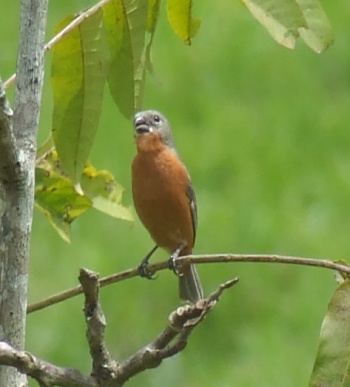
Photo © by Niels J. Larson
Yahiza Wetlands, Darien, Panama, 22 January 2018
- Sporophila minuta
Identification

Photo © by Joseph Morlan
Old Gamboa Road, Summit, Panama, 27 January 2010
8·6–9·6 cm (3¼-3¾ in)
Male nominate:
- Quite variable with brown and gray morphs.
- Grey crown and face
- Grey, streaky back
- Lower back and rump rufous
- Distinct white rectangular patch on folded wing.
- White spot at bill base
- Entire underparts rufous
- Eye, bill and legs dark
Female: Nondescript, warm buffy brown on crown, nape, mantle and back. Breast similar buff-brown contrasting with paler throat. Darker color extending to flanks and contrasting with paler belly and vent.
Juvenile: Like female; immature male gradually acquires adult-like features.
Similar Species
Within range female difficult to separate from female Yellow-bellied Seedeater. Ruddy-breasted Seedeater is smaller, lacks yellow tones on its underparts and has more pale fringing on its wing coverts.
Variations
Race parva male is more blue-grey above lacking brownish tones of nominate. Female warmer buff than other races. Race centralis male is similar to nominate but smaller and browner above. Female like nominate.
Distribution
Central and South America:
Central America: found in Mexico, Guatemala, El Salvador, Honduras, Nicaragua, Costa Rica, Panama, Trinidad
South America: Colombia, Venezuela, Guyana, Suriname, French Guiana, Ecuador, Bolivia and Brazil
Taxonomy
Subspecies
There are 3 subspecies[1]:
- S. m. parva:
- S. m. centralis:
- South West Costa Rica and Pacific slope of Panama
- S. m. minuta:
Habitat
They like open spaces and are often seen beside roads, in parks and close to houses.
Behaviour
Diet
Their main diet consists of grass seeds.
Breeding
They construct an open cup nest from grasses notable because it usually contains a few stem grass stems that stick up above the rim of the cup. Clutch 2-3 white eggs with brown spotting.
Vocalisations
Song is simple but plaintive and sweet, see-seeur tee-te-e-e-e, seeeeeur tse-e-e-e. Call variable sharp chip or chunk.
Movements
Mostly sedentary, but may disperse when food is scarce because of drought.
References
- Clements, J. F., T. S. Schulenberg, M. J. Iliff, D. Roberson, T. A. Fredericks, B. L. Sullivan, and C. L. Wood. 2018. The eBird/Clements checklist of birds of the world: v2018. Downloaded from http://www.birds.cornell.edu/clementschecklist/download/
- Avibase
- Rising, J. & Jaramillo, A. (2019). Ruddy-breasted Seedeater (Sporophila minuta). In: del Hoyo, J., Elliott, A., Sargatal, J., Christie, D.A. & de Juana, E. (eds.). Handbook of the Birds of the World Alive. Lynx Edicions, Barcelona. (retrieved from https://www.hbw.com/node/62129 on 10 January 2019)
- BF Member observations
- Ruddy-breasted Seedeater (Sporophila minuta), In Neotropical Birds Online (T. S. Schulenberg, Editor). Cornell Lab of Ornithology, Ithaca, NY, USA. retrieved from Neotropical Birds Online: https://neotropical.birds.cornell.edu/Species-Account/nb/species/rubsee1
Recommended Citation
- BirdForum Opus contributors. (2025) Ruddy-breasted Seedeater. In: BirdForum, the forum for wild birds and birding. Retrieved 14 May 2025 from https://www.birdforum.net/opus/Ruddy-breasted_Seedeater





